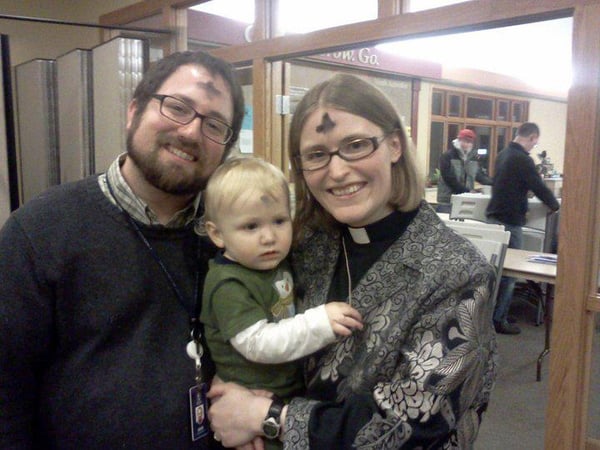Blow the trumpet in Zion;
sanctify a fast;
call a solemn assembly;
gather the people.
Sanctify the congregation;
assemble the aged;
gather the children,
even infants at the breast. Joel 2:15-16 (Ash Wednesday, Year A)
My first Ash Wednesday as a pastor, I was taken aback by the tenderness of it: with each cross I traced on the foreheads of the dear ones gathered that night, I felt God’s tangible love for that person and their precious, singular life. My first Ash Wednesday as a pastor and a mom, I had to give myself a pep talk: I would trace the cross I made when I baptized Walter just a few weeks before. I would let myself feel that love and tenderness for him and for his precious life, but I would also be prepared and not overwhelmed by it. When I saw my husband, Sean, step forward, holding baby Walter, I took a deep breath. I approached him gently and lovingly, with my thumb covered in ashes: “Walter, remember you are dust . . .”
And he dodged.
Surprised, Sean and I smiled, and Sean readjusted the baby to give me a better angle on his forehead. I tried again. Walter dodged again. And then a third time. By now, Sean and I were giggling, and many in the congregation were, too. It was funny! And I was a little proud, too, thinking, “That’s right, Walter. Do not go gentle into that good night.”
It was not the moment I prepared for, but it was the kind of holy and wholly human moment that Ash Wednesday—that all liturgy, really—is made for. God meets us in moments like these: unexpected and unplannable, and made possible because we planned a time of ritual and connection in community. On Ash Wednesday this year, we hear the exhortation of the prophet Joel to call a solemn assembly and to not leave any age group out of the gathering. The contributions children make to worship are vital, even and especially at solemn assemblies like Ash Wednesday.
 Pastor Annie Edison-Albright with her husband, Sean, and her son, Walter, on Ash Wednesday in 2013. It was a little past his bedtime, but so good to have Walter there that they took a picture to remember the day. In the background, volunteers from the congregation take down tables from the dinner that came before worship (which made it possible for many people, including families, to come straight from work to church that evening).
Pastor Annie Edison-Albright with her husband, Sean, and her son, Walter, on Ash Wednesday in 2013. It was a little past his bedtime, but so good to have Walter there that they took a picture to remember the day. In the background, volunteers from the congregation take down tables from the dinner that came before worship (which made it possible for many people, including families, to come straight from work to church that evening).
What’s an Ash Wednesday? Should I bring my kids?
It’s helpful to not assume that everyone knows what Ash Wednesday is. Explaining what’s going on to your congregation helps all kinds of people: visitors who are new to Christianity, people from other traditions and faith backgrounds, and curious kids (and their parents). The way you describe Ash Wednesday in your bulletin, calendar, and announcements will help people know what to expect and that people of all ages are welcome.
Here’s some of the language we’re using to describe Ash Wednesday at Luther College this year, edited slightly with more intergenerational contexts in mind: “Ash Wednesday marks the beginning of the season of Lent for many Christians: it is a gathering where readings and prayers introduce a season for reflection and prayer as well as a time to take intentional action for both charity and justice. The imparting of ashes—a time where people can choose to receive the sign of the cross marked in ashes on their foreheads—is a tangible, tender act of blessing and a reminder for people of all ages that we are human beings, and that our lives here aren’t permanent, but they are precious, beautiful and beloved.”
Questions and ideas for planning
Questions to consider while planning for Ash Wednesday with all ages in mind:
- What time will our service be? There’s no one perfect time for all people and all life stages, but a 7:00-8:00 p.m. service may be doable for many families with young kids. An earlier service may be possible if dinner is provided before worship.
- Will there be a children’s message? Getting kids ready to receive the ashes can help make the experience less scary and feel more like a blessing and act of care. Give kids information (where the ashes came from, how they’re made, what they mean, even what they feel like if you’re ready with a wet washcloth) so that they can give consent to you or whoever is imparting the ashes.
- We use the term “imposing” but “imparting” feels better . . . adults often choose to stay seated if they don’t want to receive ashes on Ash Wednesday, but kids are brought up to receive them and may realize they don’t want them in the moment. Talk with your worship leading team ahead of time to give options to bigger kids (“May I draw it on your hand?”) or just give a loving smile to the littlest ones who give you the dodge.
- If you normally have nursery support on Sunday morning, can you arrange to have nursery support during this service, too? What other supports do you offer on Sunday morning (bags with quiet toys, pray ground) that would be helpful to have available on this night, as well?
Entering the tunnel
A few years ago, my daughter Sally became really interested in images of Jesus, crucified. I wanted to relieve any worry or anxiety she had; I wanted to skip right to Easter. “Shhhhhhh,” she told me. “This is important.” And she went back to observing the crucifix. It is important for our kids to experience the fullness of Lent, just like it’s important for us to go through the full season, too, without skipping to the end.
When kids are experiencing negative emotions, we can think of it as them entering a tunnel: as parents, we may want to grab them out of that tunnel as fast as we can, but the sadness or anger or whatever the emotion is will last as long as its going to last . . . the tunnel is as long as it is. Our job is to ride through the tunnel with them and let them know we’re with them, that they’re safe. When we take our kids to Ash Wednesday, we enter the tunnel together: not just the tunnel of Lent that ends on Easter morning, but the tunnel of life on Earth that ends with the resurrection we’ve all been promised through Jesus Christ. The sign of ashes we receive together is a mark of recognition: we are in this together, we are not alone. For all who are planning Ash Wednesday worship: blessings and prayers with you as you steward this gift, this gathering of the aged, the children and even nursing children who come together to marked with the sign of our shared life, our shared death, and our shared hope for this life and the next.



